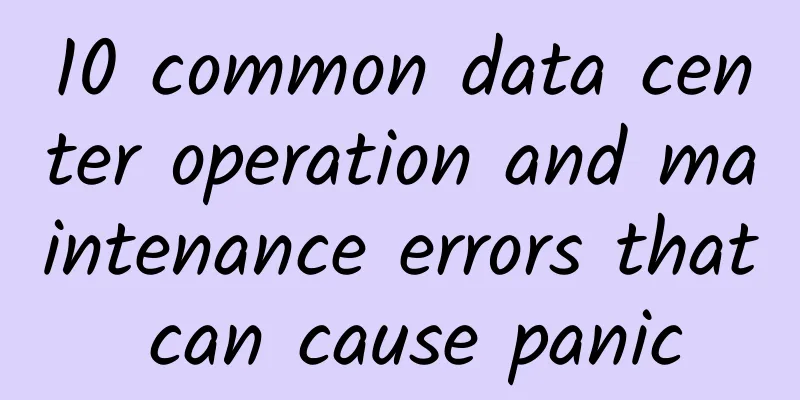10 common data center operation and maintenance errors that can cause panic

|
Some common sense mistakes can reduce the data center's competitive advantage in terms of improving reliability and saving costs. Here are some issues that enterprises need to pay attention to. Currently, when SMEs consider migrating servers to data centers, they can either rent an existing data center or build their own data center. Regardless of which model is adopted, enterprises must avoid the possible pitfalls. But how do enterprises know what to avoid? Here are 10 common pitfalls to watch out for: (1) Insufficient virtualization If your business isn't virtualizing, you're already behind. And if you don't virtualize your data center, you're not only behind, but you're also spending more money. Why dedicate hardware to each task when you can have one hosting virtual servers? Not only does this save money, it saves space and, ideally, creates a more reliable environment.
(2) Limited scalability If an enterprise builds a data center without considering expansion, it will limit future development. When building a data center, in order to adapt to business growth, enterprises need to reserve a large amount of RAM and hard disk space for the server, and even reserve enough space for the data center. According to past experience, when building a data center, enterprises need to consider doubling the capacity so that there is enough room for expansion. (3) Insufficient cloud computing resources Cloud computing is a flexible resource that every medium-sized enterprise should be able to use flexibly. Enterprises can create their own cloud platform or purchase cloud space from AWS. No matter which way you choose, you can set up a more flexible data center experience. Even if you can only use cloud storage, at least the enterprise can continuously expand the storage space without constantly adding new hardware. (4) Poorly managed servers You may have seen the results of poor server management. When this happens to us, things can be even worse. You need to ensure that your servers are kept up to date, with backup data, backup power supplies, and other services that require regular maintenance. (5) Improper design and narrow racks When the staff is working on the rack, will the patch panel cables be too dense to reach? The rack design should be easy to operate (from the front and back). The patch panel must be clearly labeled and the cables should be neatly bundled and properly tied. Don't mix all the equipment together, which will take a lot of time to design the rack layout. (6) Insufficient power supply in data center If the enterprise's data center does not have enough electricity, it may easily encounter power outages. What will happen when a large number of servers in the enterprise are running at the same time and the power capacity is insufficient? Therefore, when enterprises design or choose their own data centers, they must pay attention to reserving enough power capacity, not just enough or too little. (7) Weak safety awareness Many people assume that because they already use a data center facility, security is no longer an issue. But don't assume so. No matter how your server is deployed, always put security first. No data center can guarantee 100% data security. Therefore, companies should have redundancy when deploying servers, and also need to have extra precautions and protection awareness to deal with threats. (8) Poorly designed remote access You must be able to access your servers remotely, either from within the enterprise or within the company. You need to make sure you have multiple methods for access and that they are secure. If you rent a data center that provides a control panel-type remote gateway for access, use it, but don't rely on it. (9) Insufficient budget When an enterprise makes a budget before building a data center, make sure that it can meet its needs in the next five to ten years. Otherwise, expansion will be difficult to achieve its expected goals. In addition, the budget must be sufficient, not just enough or less. (10) Failure to notify customers of maintenance or downtime If your data center has a hosting service, make sure you alert its users in advance of downtime. If there is a problem and for some reason the server fails, alert your users to the issue and work to resolve it. Don’t just cancel service without alerting your customers, or you’ll lose more than just data. You could also lose valuable customers. Data centers can support the expansion of an enterprise's business. If an enterprise needs to purchase data center space or build its own data center, please pay attention to the above issues to avoid falling into a state of confusion or delaying its expansion plan due to lack of funds. |
<<: Does it just look familiar? What is the advantage of 802.11ac Wave2?
>>: Robotics and AI: The future of software testing and development
Recommend
Review of 2021丨Highlights of the three major operators
2021 is the first year of implementation of my co...
Actual measurement: The truth about 5G high-speed downloading: monopoly, speed limit and lies
On June 6, 2019, the Ministry of Industry and the...
Deutsche Telekom recently successfully tested 5G independent networking
Deutsche Telekom (DT) said it has completed its f...
Why Thread will unify IoT communication protocols in the future
Various devices connected to the Internet of Thin...
FONE Consolidation: Reshaping the productivity of consolidated financial statements under the trend of business and financial integration
For large group companies, the preparation of con...
Infinitely faster than Protocol Buffers, Cap'n Proto 1.0 is finally released after ten years of open source
Cap'n Proto is an extremely fast data exchang...
GSMA: China is expected to have 460 million 5G connections by the end of 2025
Recently, GSMA released its latest report "C...
With the support of celebrities, how fast can 5G run?
With the freezing of 5G 1.0 version, the first co...
Three Misconceptions about Edge Computing
With millions of machines and objects connected t...
Miss 5G's "Martial Arts Competition to Win a Husband"
Xiao Z: Ladies and gentlemen, welcome to our Miss...
What can operators do to ensure that fee reductions are real and consumers understand clearly?
This year, speed increase and fee reduction have ...
WOT Cheng Chao: Alibaba's monitoring development path from automation to intelligence
[51CTO.com original article] On May 18-19, 2018, ...
Exploration and practice of full-link grayscale solution based on Istio
background Under the microservice software archit...
BACnet protocol: building a communication bridge for intelligent buildings
In the field of intelligent buildings and automat...
The management and configuration of routers and switches will definitely refresh your mind!!!
1. Management and configuration of routers and sw...









